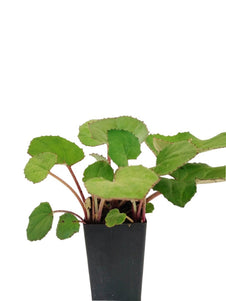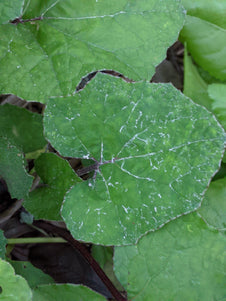





Coltsfoot
Coltsfoot
- Low stock - 9 items left
- Inventory on the way

Usually available: All year
Life cycle: Herbaceous Perennial
Height: 10 - 30cm
Position: Sun / part shade
Soil preference: Moist / well drained
This is how we pack and send your Herb Plants to all states except TAS & WA
You will receive
- 1 Coltsfoot Herb Plant in a 50 X 75mm tube - General growing instructions
All of our Herb Plants are grown organically with certified organic potting mixes and fertilizers
Botanical Name: Tussilago farfara
Coltsfoot is a perennial herbaceous groundcover, with the typical bright yellow flowers that characterise the Asteraceae family. The flowers are fragrant, even when dried and are similar to a tufty dandelion, although they are flat and a little smaller. The leaves are slightly lobed and resemble the underside of a colt’s foot, being described as hoof-like. The jade coloured leaves can grow 10 cm or more across and have prominent white veins that spread spider like across the leaf surface.
The natural habitat of Coltsfoot is the moist, heavy soils of England and Europe with its range extending into some areas of Northern Africa and Asia. However, it has now become naturalised through North America and Canada, where they will grow anywhere that has sandy and moist soils.
This herb has the distinction of being one of nature’s oddities because the flowers appear before the leaves. It has been called ‘son before the father’ or more simply, ‘cart before the horse’. On more official terms, some sources suggest that the name tussilago actually means ‘cough suppressant’ or ‘cough dispeller’ while others explain that ‘tussis ago’ refers to the phrase “I drive away a cold."
As with all herbs, it is important to remember that many herbs contain very potent chemicals. Coltsfoot contains pyrrolizidine alkaloids which may contribute to liver toxicity with excessive or long term use.
Growing Conditions
Coltsfoot grows to about 10-30 cm in height and may be a little confusing in its habits. From August to October, the daisy like flowers will appear on stalks without any leaves and wither after setting their seed. Once this happens, large leaves resembling the underside of a colt’s foot appear. These eventually wither and create the impression of a plant that has not flowered. If you miss seeing the flowering, it may be quite confusing and disappointing. Just make sure you mark the calendar to catch next year’s early season flowering!
This plant has a spreading growth habit, using its very efficient rhizomes. Many herb growers say it is actually very hard NOT to grow coltsfoot and choose to keep it in a container. In some states of Australia, this plant has been declared a weed, so please check your local information. Due to spreading growth habit, coltsfoot often appears in small to medium groups, spreading up to a meter.
Coltsfoot is a very tough plant and will grow well in most conditions, including damp clay soils. The best position is a full sun, but coltsfoot is tolerant of semi shade as well.
Culinary Uses
Coltsfoot flowers and buds have a pleasant aniseed flavour, while the leaves can be quite bitter. All can be used in salads, but the more common use is in tea for medicinal purposes.
Medicinal Uses
Coltsfoot has been used very effectively in the treatment of coughs and bronchial congestion for centuries by using the leaves brewed in a tea. Today Coltsfoot remains one of the most effective herbal cough expectorants recommended by herbalists. As a topical agent, it is also useful for inflammation of cuts and sores, and has an antimicrobial effect.
All information provided on this website is for informational purposes only. Please seek professional advice before commencing any treatment.





